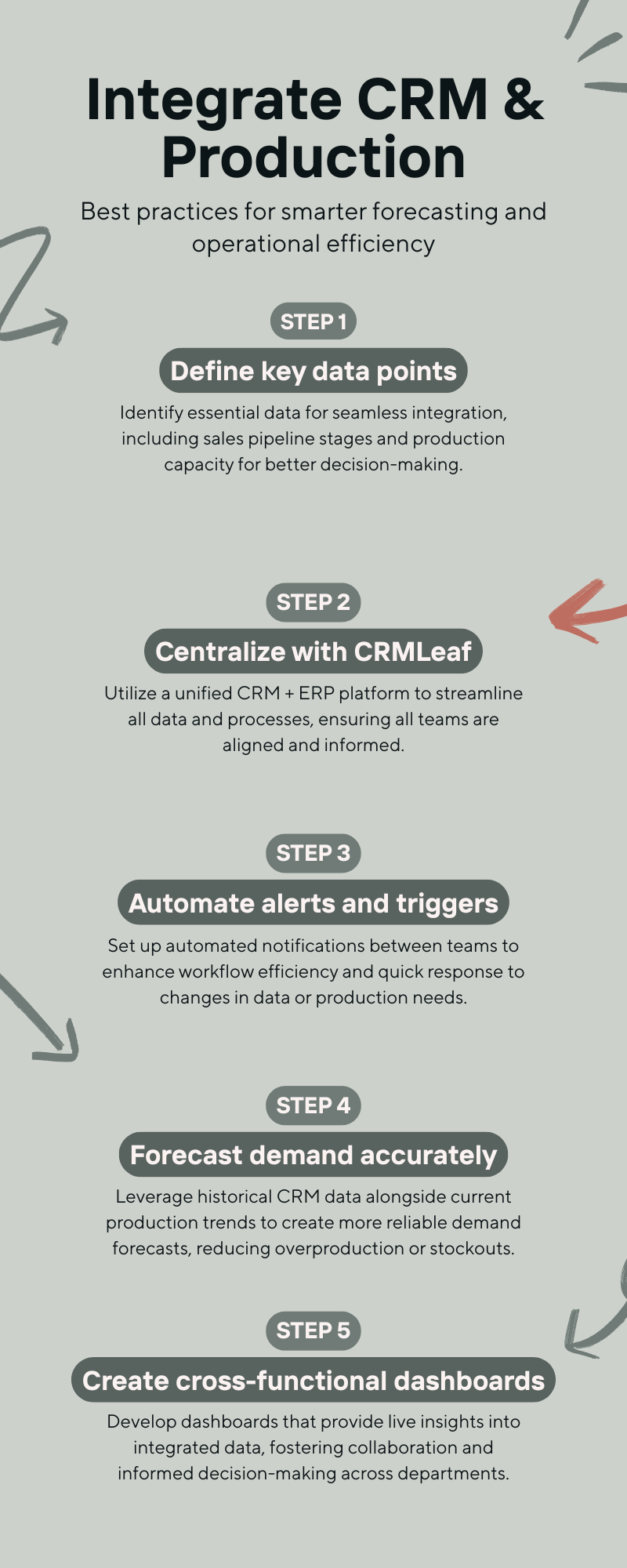Did you know that 43% of companies miss delivery deadlines due to poor production forecasting? For small and mid-sized businesses, especially in manufacturing, distribution, or retail, this gap directly affects profits and customer satisfaction. A major reason for this is the lack of integration between your CRM system and production operations.
If your Customer Relationship Management (CRM) tool is packed with sales data, but your production team is still relying on outdated spreadsheets or gut instinct, you’re operating with blind spots.
In this blog, we’ll explore how integrating your CRM system with your production line leads to better forecasting, smarter decisions, and streamlined operations. Whether you’re an operations manager, CFO, or part of HR & Payroll firms, these insights will guide you through actionable strategies.
Why Connecting CRM System and Production Is a Game-Changer for Growing Businesses

As your business grows, so does the complexity of demand and supply. If your Customer Relationship Management software and production processes run in isolation, you face challenges like:
- Mismatch between production capacity and demand. Teams can’t plan accurately without unified insights.
- Inefficient inventory planning. Overstocks or stockouts eat into margins and disappoint customers.
- Fragmented customer experience. Delays or broken promises affect retention and reputation.
Real-World Scenarios:
- A retail brand runs a promotion, but production doesn’t scale in time — delivery delays follow.
- A manufacturing firm accepts a bulk order without visibility into raw material availability.
- A wholesale distributor promises fast delivery, unaware of warehouse bottlenecks.
With integration, your CRM system feeds real-time sales data into production planning. This empowers:
- Real-time visibility into incoming orders and expected workload.
- Smarter forecasting using actual sales trends, not guesswork.
- Optimized scheduling and procurement aligned with demand signals.
Best Practices to Integrate CRM System & Production for Smarter Forecasting
Here are practical, proven steps for seamless integration of your Customer Relationship Management software and production operations:
1. Define Key Data Points That Need to Flow Between Systems
- Sales and production must speak the same language. Pipeline stages, lead scoring, expected close dates, and customer priorities should be accessible to the production team.
- Operational data in the CRM. Production capacity, lead times, and current output should be visible in the CRM so sales reps can make accurate commitments.
2. Use a Unified CRM + ERP Platform Like CRMLeaf
- CRMLeaf consolidates everything under one digital roof — from sales and inventory to procurement and human resource software.
- No more manual data entry or siloed updates. With real-time visibility, both sales and operations align effortlessly.
3. Automate Alerts and Triggers Between Teams
- Instant notifications for order stages. Set up alerts so production is informed when a quote turns into a confirmed deal.
- Capacity-based sales guidance. Sales gets notified if production is nearing overload, helping prioritize and set realistic timelines.
4. Forecast Demand Using Historical CRM Data
- Tap into CRM’s rich customer history. Analyze trends, buying behavior, and seasonality for more accurate planning.
- CRMLeaf connects this with current production metrics, enabling synchronized supply chain decisions.
5. Create Cross-Functional Dashboards
- Dashboards should unite stakeholders. Sales, production, finance, and even HR & Payroll firms benefit from real-time insights.
- Custom views for each team. CRMLeaf lets you build dashboards that serve different departments while pulling from a single data source.
6. Train Your Teams to Read and Respond to Integrated Data
- Technology is only useful if your people use it right. Conduct regular training on interpreting live dashboards and demand signals.
- Create SOPs for adaptation. Ensure teams know what to do when demand spikes or supply faces disruptions.
7. Set KPIs to Measure the Success of the Integration
- Track what matters. Focus on metrics like forecast accuracy, on-time delivery, production turnaround, and satisfaction scores.
- Refine based on results. Use CRMLeaf’s analytics features to adjust and improve continuously.
Customer Success Story
For example, GreenFlow Manufacturing, a mid-sized electronics parts supplier, struggled with fulfillment delays and inventory shortages. Their sales team used a CRM system, but production was managed in spreadsheets.
After integrating their systems with CRMLeaf’s all-in-one CRM + ERP platform:
- They synced sales forecasts with real-time production capacity.
- They reduced fulfillment time from 14 days to 7 days.
- Forecast accuracy improved by 45%.
- Customer retention jumped by 20%.
Now, both sales and operations teams use the same document control software, dashboards, and alerts, eliminating guesswork and bottlenecks.

Key Takeaways: A Clear Path to Forecasting Excellence
Combining your CRM system with production management isn’t just an IT upgrade — it’s a strategic enabler.
Benefits at a Glance:
- Forecast with precision. Real-time insights from your Customer Relationship Management software reduce planning errors.
- Deliver on time, every time. Automation and alerts reduce delays and improve client trust.
- Unify all your data. CRMLeaf integrates sales, HR, payroll, and production into one seamless workflow.
- Make HR a part of planning. Leverage features like attendance software, payroll services, and legal document management to ensure your workforce is always aligned.
- Continuous improvement. KPIs and dashboards help optimize your entire pipeline — from lead to delivery.
By adopting a unified solution like CRMLeaf — complete with Human Resource Management, All in One HR Software, and powerful document management — you can scale smarter, not harder.



